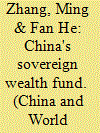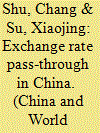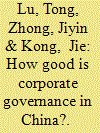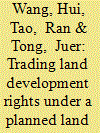|
|
|
Sort Order |
|
|
|
Items / Page
|
|
|
|
|
|
|
| Srl | Item |
| 1 |
ID:
086472


|
|
|
|
|
| Publication |
2009.
|
| Summary/Abstract |
China's financial conundrum arises from two sources. First, its large saving (trade) surplus results in a currency mismatch because it is an immature creditor that cannot lend in its own currency. Instead, foreign currency claims (largely US dollars) build up within domestic financial institutions. Second, economists, both American and Chinese, mistakenly attribute the surpluses to an undervalued RMB. To placate the USA, the result was a gradual and predictable appreciation of the RMB against the dollar of 6 percent or more per year from July 2005 to July 2008. Together with the fall in US interest rates since mid-2007, this oneway bet in the foreign exchanges markets not only attracted hot money inflows but inhibited private capital outflows from financing China's huge trade surplus. Therefore, the People's Bank of China had to intervene heavily to prevent the RMB from ratcheting upwards, and so became the country's sole international financial intermediary as official exchange reserves exploded. Because of the currency mismatch, floating the RMB is neither feasible nor desirable, and a higher RMB would not reduce China's trade surplus. Instead, monetary control and normal private-sector finance for the trade surplus require a return to a credibly fixed nominal RMB/USD rate similar to that which existed between 1995 and 2004. However, for any newly reset RMB/USD rate to be credible as a monetary anchor, foreign "China bashing" to get the RMB up must end. Then the stage would be set for fiscal expansion to both stimulate the economy and reduce its trade surplus.
|
|
|
|
|
|
|
|
|
|
|
|
|
|
|
|
| 2 |
ID:
086482


|
|
|
|
|
| Publication |
2009.
|
| Summary/Abstract |
The establishment of sovereign wealth funds in large developing countries has generated hot debate among participants in the international financial market. When accumulated foreign exchange reserves surpass a sufficient and an appropriate level, the costs, risks and impacts of holding reserves on the macroeconomy of a country need to be considered. The Chinese Government established China Investment Corporation (CIC) in 2007 to diversify its investment of foreign reserves and to raise investment income. However, because of certain conflicts of interest and institution-design caveats, CIC possesses some internal weakness, including a vague orientation, mixed investment strategies and an inefficient bureaucratic style. Although the subprime crisis has softened certain regulations and lessened rejection by the USA of CIC potential investments, the increased volatility and uncertainty of the market means that CIC is facing some new challenges in terms of its investment decisions. Moreover, CIC is competing with other Chinese investment institutions for injections of funds from the Chinese Government.
|
|
|
|
|
|
|
|
|
|
|
|
|
|
|
|
| 3 |
ID:
086474


|
|
|
|
|
| Publication |
2009.
|
| Summary/Abstract |
During the second half of 2007 and early part of 2008 when there were intense inflationary pressures in China, RMB appreciation was advocated as a means of helping to curb inflation. The effectiveness of appreciation in controlling inflation depends on the impact of exchange rate movements on import and domestic prices. Our analysis finds fairly large and speedy exchange rate pass-through (ERPT) to import prices: 50 and 60 percent for the short run and long run, respectively. However, the degree of ERPT decreases along the price chain from upstream to downstream prices. ERPT for consumer prices, the most downstream prices, is much milder and has substantial lags. A 10-percent rise in the nominal effective exchange rate will dampen consumer prices by 1.1 percent within a year, with very little pass-through in the first half year, and by 2.0 percent over the long run. These findings, particularly the ERPT to consumer prices, suggest that RMB appreciation can help to reduce inflationary pressures over the longer term. However, it is unlikely to provide rapid relief to the current round of high inflation because of the long lags in ERPT. The RMB needs to strengthen in effective terms to exert the desired dampening impact on prices.
|
|
|
|
|
|
|
|
|
|
|
|
|
|
|
|
| 4 |
ID:
086479


|
|
|
|
|
| Publication |
2009.
|
| Summary/Abstract |
Based on the revised OECD Principles of Corporate Governance of 2004 and China's regulatory framework, we develop a corporate governance index (CGI) to measure overall corporate governance and disclosure practices of the 100 largest listed companies in China. The results show that Chinese companies have been making progress in corporate governance reform and there is significant difference in CGI between the top and the bottom companies' performance. Among the six parts of CGI, Chinese listed companies perform better in disclosure and transparency, but show weakness in board of supervisor and stakeholders roles. Further tests show that the improvements in corporate governance of state-owned enterprises have resulted in some initial signs of success.
|
|
|
|
|
|
|
|
|
|
|
|
|
|
|
|
| 5 |
ID:
086477


|
|
|
|
|
| Publication |
2009.
|
| Summary/Abstract |
China's state planned land use system, including regulations such as setting planned quotas for land use, basic cropland preservation, and pursuing a balance between the conversion of arable land into non-agricultural use and the supplement of new agricultural land, has substantially constrained the economic growth of industrial provinces in China. This article explores the innovative reforms adopted by Zhejiang Province through land development rights (LDR) transfer within a locality and LDR trading across localities. We argue that there is a "Zhejiang model of LDR transferring and trading," which, we believe, has significant implications not only for fostering an efficiency-enhancing market for land development rights and agricultural land preservation, but also for optimal use of land and a more balanced regional development. One important policy issue relating to China's rural land system is that under China's land requisition system, farmers are usually under compensated for urban land-taking.
|
|
|
|
|
|
|
|
|
|
|
|
|
|
|
|
| 6 |
ID:
086475


|
|
|
|
|
| Publication |
2009.
|
| Summary/Abstract |
Applying a commonly used index for export sophistication in a cross-country study, Rodrik finds that the technological content of Chinese exports over the past decade has been so high that it cannot be explained simply by the economic fundamentals of a low-income country abundant with unskilled labor. Question has been raised for the empirical robustness of the index. I am also doubtful with Rodrik's analysis but develop my argument from a different perspective. This paper briefly reviews Rodrik's methodology and identifies other factors his empirical results potentially hinge on. Based on this, it elaborates on China's unique processing trade regime, the uneven distribution of its exports across Chinese regions and the limitation of HS codes in terms of identifying differentiated products, in an attempt to show that these factors also contribute to higher estimations of China's export sophistication level. Finally, it organizes trade data to reveal the trade patterns that are indeed consistent with the country's comparative advantage.
|
|
|
|
|
|
|
|
|
|
|
|
|
|
|
|
|
|
|
|
|